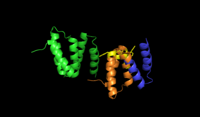
Photo from wikipedia
Homooligomerization of proline utilization A (PutA) bifunctional flavoenzymes is intimately tied to catalytic function and substrate channeling. PutA from Bradyrhizobium japonicum (BjPutA) is unique among PutAs in that it forms… Click to show full abstract
Homooligomerization of proline utilization A (PutA) bifunctional flavoenzymes is intimately tied to catalytic function and substrate channeling. PutA from Bradyrhizobium japonicum (BjPutA) is unique among PutAs in that it forms a tetramer in solution. Curiously, a dimeric BjPutA hot spot mutant was previously shown to display wild-type catalytic activity despite lacking the tetrameric structure. These observations raised the question of what is the active oligomeric state of BjPutA. Herein, we investigate the factors that contribute to tetramerization of BjPutA in vitro. Negative-stain electron microscopy indicates that BjPutA is primarily dimeric at nanomolar concentrations, suggesting concentration-dependent tetramerization. Further, sedimentation-velocity analysis of BjPutA at high (micromolar) concentration reveals that although the binding of active-site ligands does not alter oligomeric state, reduction of the flavin adenine dinucleotide cofactor results in dimeric protein. Size-exclusion chromatography coupled with multiangle light scattering and small-angle x-ray scattering analysis also reveals that reduced BjPutA is dimeric. Taken together, these results suggest that the BjPutA oligomeric state is dependent upon both enzyme concentration and the redox state of the flavin cofactor. This is the first report, to our knowledge, of redox-linked oligomerization in the PutA family.
Journal Title: Biophysical journal
Year Published: 2018
Link to full text (if available)
Share on Social Media: Sign Up to like & get
recommendations!